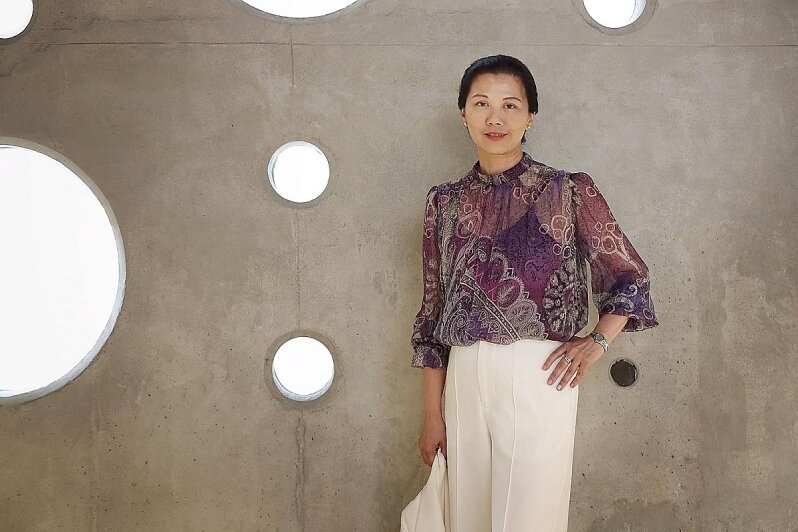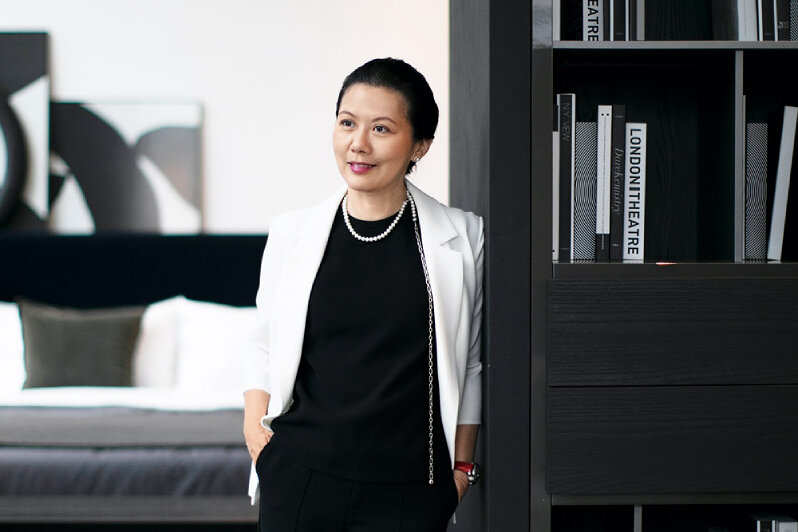Our “I Am Her” series features the female movers and shakers of the industry to learn how femininity and power coincide beautifully and seamlessly together.
Great things come in small packages. Case in point? Singapore Fashion Council’s Semun Ho, who leads with purpose and #keepsitreal about the opportunities and challenges of operating within Singapore’s fashion ecosystem.

Meet Semun Ho, the CEO of the Singapore Fashion Council.
For a petite woman (she’s a little under 5”1!), she makes a huge impact. Prior to her current role as the CEO of the Singapore Fashion Council, Semun held management roles at various organisations, including SGTech, Motorola Electronics and the Singapore office of New Jersey-based consulting firm Caliper. In addition to these experiences, she also sits on multiple committees, such as the Design Education Advisory Committee (DEAC) to strengthen the ties between educational institutions and the local fashion industry.
Read on as Semun shares with us her take on the future of Singapore fashion, the country’s attitudes towards conscious fashion consumption, and what “living the most beautiful life” looks like to her.
Fill in the blank (be as creative as you like): I am the CEO of the Singapore Fashion Council, a tech veteran and .
“A lifelong student.”
You spent years working in the tech sector before stepping into your current role, which focuses on championing the local fashion scene. What is the biggest similarity — and difference — you’ve observed between these two industries?
“The similarities between the sectors are not agnostic to them — in a cosmopolitan city like Singapore, most local small to mid-sized companies would have similar challenges, such as attracting the right talents, and scaling to international markets.
A commonality that I have seen however is with regards to misunderstandings on what construes as jobs in the sector — for tech, many think of only programmers and IT support; and for fashion many equate the industry to be just the end product of apparel and accessories and think that jobs in the fashion industry are fashion designers and fashion retail-related jobs. As it stands, both these industries actually offer a much more variety of jobs and experiences.
Some key differentiations — the ecosystem for the tech industry is much bigger and more vibrant, while for the fashion industry, due to land and labour cost challenges, most fashion manufacturing is done offshore, resulting in Singapore lacking a big part of the fashion ecosystem.
Also, the investment scene is more active in the tech industry compared to the fashion scene (as many equate fashion to just apparel and accessories). This is why we started The Bridge Fashion Innovator (TBFI) programme, to address this gap in incubation in the local fashion industry.”
The Textile and Fashion Federation rebranded itself and is now officially known as the Singapore Fashion Council (SFC). What has changed and what remains important to the association?
“SFC has always focused on Innovation and Technology, Sustainability and Asian Craftsmanship and Culture. Rebranding allows us to articulate this focus more clearly and elevate our engagement beyond manufacturing and apparel designers and brands. We want to be more inclusive and to engage the fashion ecosystem — from fibres to post-consumption — and also to include professionals such as stylists, models and teachers.
One of the key things that we will continue to do is to promote the local companies that are in the fashion industry. This, however, does not only include brands but also material innovators, technology innovators, platform providers, and more. We will continue to build resources, provide networks, develop capabilities and support Go-To-Market programmes for these companies.”
It’s refreshing how you #keepitreal when discussing the challenges of thriving in Singapore’s fashion scene. With this, what’s one key important lesson that people must know about the local fashion industry?
“The key lessons differ from audience to audience.
For brand owners, they must know that to succeed in this industry, there are several important factors they should build into their brand. For one, they need to build sustainability as part of their narrative. They also need to engage innovations and technology in order to be more efficient, and perhaps create differentiation and different business opportunities. In view of this, SFC is consistently providing updates, resources, networks and programmes for brands to upgrade themselves.

“In order to succeed, brand owners must build sustainability as part of their narrative,” advises Semun.
For multinational companies (MNCs) based in Singapore, they ought to engage the local community to truly unlock the potential of this place. We are happy that increasingly, SFC has been able to engage MNCs to elevate the local fashion industry because it is with this concerted effort that we can develop talents locally and attract talents to join us as well.
For Institutes of Higher Learning (IHLs), the fashion industry needs scientists, marketing and general management talents as well. As such, we are working with schools to widen our engagement and avail internships and job opportunities beyond just fashion designers.”
What do you reckon Singapore fashion will look like in the next decade?
“I hope that it will go beyond local-themed apparel and accessories. Instead, it would have grown into a regional hub that is recognised for innovative and sustainable fashion products and services, standards and policies.”
What is your take on Singaporeans’ attitudes towards conscious fashion consumption? How can locals be motivated to consider — and eventually consume sustainable fashion?
“Singapore has a complex stance towards conscious fashion consumption, and likewise to motivate them to be more sustainable in their consumption, a many-tiered solution is also required.
Firstly, there needs to be better awareness regarding the meaning of sustainable fashion. To achieve this, SFC has set up a website to encourage Singaporeans to take the first step towards becoming more conscious consumers. Many IHLs are already integrating environmental studies into their syllabus.
This is a good start. And in time, the hope is that the younger generation — who we are seeing more conscious shoppers of — will be able to positively influence their older family members who eventually, also demand products to be more sustainable.
In a recent discussion at a DEAC meeting, there was an agreement that people must be inspired and empowered to do the right thing and to do so, we need to provide the right ‘ingredients’. And at the appropriate time, add a dose of legislation to accelerate the adoption of more conscious consumption.”
Is there a person whom you deeply admire or look up to in the local fashion scene? How have they positively impacted your outlook on fashion — or even perhaps on life?
“I draw inspiration from a diverse group of people — this includes politicians, business leaders, designers (not only just fashion), our varied partners as well as from my colleagues and team at SFC. There are too many invaluable lessons I have drawn from them that have influenced my outlook on life and fashion.”
What’s one ‘fail-proof’ ensemble or beauty item that never fails to give you a confidence boost?
“‘Fail-proof’ ensemble? A pair of pants with an interesting top, completed with an accessory.”
What does living ‘your most beautiful life’ mean to you?
“Fitting into my yoga gear and finishing a session of yoga!”
This interview has been edited for clarity and brevity.
Feeling inspired? Read more empowering stories about women here.
Comments, questions or feedback? Email us at [email protected].








